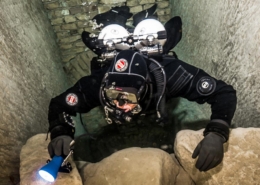3 Finning Techniques (Video) – Frog Kick, Helicopter Kick, Reverse Back Kick
by Lauren Kieren:
The fundamental skills for all divers include buoyancy control, swimming techniques, proper body positioning, and breathing. These skills allow the diver to remain in control and dive efficiently. While each skill set has unique aspects when taken on alone; they work best when combined. For the purpose of this text, we are simply going to focus on swimming techniques.
A diver should be able to move through the water using their fins as the exclusive means of propulsion to increase efficiency and minimize the impact to the environment. The use of arms and hands provide very little to the diver’s ability to push through the water and are more likely to cause overexertion.
So, which scuba finning techniques should we focus on and when are we actually going to use them?
After a survey of preferred finning (or kicking) styles used by technical divers, we narrowed it down to the top three finning techniques which we will further discuss in detail.
Frog Kick (Video)
Technical divers commonly use the frog kick as their primary finning technique of choice since the force of this stroke is directed toward the rear of the diver rather than downward to avoid silt. In addition, the frog kick propels the diver through the water easily, while requiring the least amount of work.To start the frog kick, bend both knees at a 90° angle outward and upward, while spreading the lower legs apart horizontally allowing your fins to be parallel to the bottom. The next step is to straighten out the legs while thrusting the fins rearward in an arc shape then clapping them together.
Divers commonly use a variation of this finning technique, called the “modified frog kick” which can be completed by reducing the size of the arc needed to propel the diver forward and kicking mainly from the knees and ankles.
Helicopter Turn (Video)
Diver’s can rotate their body on axis without moving forward, backward, or using their hands by doing a helicopter turn (sometimes referred to as a sculling kick). This is a great finning technique to use in a cave or wreck when a diver needs to turn around without stirring up silt or affecting the bottom. To complete a helicopter turn, the diver slowly moves their fins apart horizontally in an opposing back-and-forth motion, while simultaneously rotating the ankles and fin blades around their own axis.
Reverse or Back Kick (Video)
Divers can back up, just like a car, by completing a reverse frog kick. This finning technique allows you to move away from divers, slow down forward motion as necessary, or back out of a tight spot and maintain your position in the water column without using your hands. The diver should begin with their legs straight back and their ankles together. Next, the diver flexes their ankles outwards and draws the angled fin tips outwards by spreading the knees and pulling the fins back towards the upper part of the body.
Summary
When a diver is skilled in multiple finning techniques, they have the advantage of being able to switch as needed throughout a dive. The diver should utilize appropriate finning techniques to match the immediate conditions encountered to increase efficiency and minimize the impacts to the environment.
Regardless of the finning technique used, the diver may need to slow down in order to speed up. Since drag is a function of speed, divers need to slow down in order to allow the water they are moving for propulsion time to move past them. Proper finning should allow for some glide after each kick. Divers often forget about this part of the swimming cycle, and in turn create more drag slowing their progress
For more information, or to improve your finning techniques, contact your local TDI Dive Center or Instructor.
Like what you’re reading? Go VIP
Join the 100,000+ subscribers getting exclusive content, private Q & A’s, awesome interviews and more. No spam, ever. Just great stuff!










Leave a Reply
Want to join the discussion?Feel free to contribute!